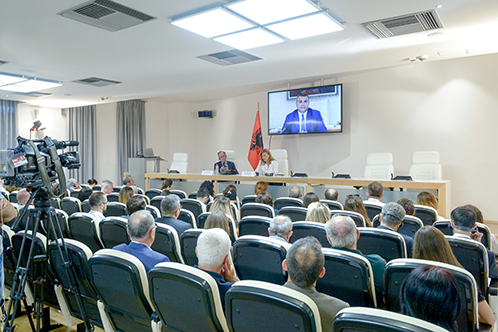BANK OF ALBANIA
PRESS RELEASE
Governor Sejko: Welcome address, the Second Conference of the Museum of the Bank of Albania
Publication date: 20.09.2018
Distinguished professors,
Dear participants,
It gives me a great pleasure to welcome you to the Second Conference of the Museum of the Bank of Albania, via this recorded message. I wish I were present to attend in person the proceedings of the Conference, but, regrettably, due to the rather tight agenda I will not be able to. Nevertheless, I will have the possibility to read all the presentations, discussions, and input in the Conference book that will be compiled subsequent to the Conference.

As I have already emphasised, the Conference of the Museum of the Bank of Albania is one of the most prominent events, providing us with the opportunity to enrich and further the studies on the exposed collections, and serves as a platform for Albanian experts to discuss and share their research findings.
We are pleased to see that the Museum of the Bank of Albania brings for the second time together representatives from renowned research institutions, such as: the Albanian Institute of Archaeology and History, European Universities and central banks to present their studies.
As the title suggests, this Conference will address the role of money in wartime. In periods of wars and conflicts - history shows that, albeit relatively small, Albania has experienced many wars and conflicts - people have turned to the currency and precious metals. Hence, about 100 years ago, at the beginning of the World War I, Europe dived into one of the worst financial crises of the past century and many people and businesses rushed to convert their bank accounts and assets into cash and gold coins.
Meanwhile, in Albania, these events triggered a chaotic monetary circulation. In the absence of a national currency and due to the political-military and economic developments during the War, diverse foreign currencies circulated across the country, mainly those of European and neighbouring countries, as well as American and Turkish ones.
You may see this conglomerate of denominations in the showcases of the Museum dedicated to the period of Independence and the World War I. Also, the showcases on the monetary circulation in Albania during World War II, in addition to the ones of Antiquity and Medieval periods, exhibit denominations that speak of the important and complicated relationships between money and war. I am sure these important moments to the economic and monetary history of Albania, and beyond, will be discussed at length during the Conference.
Dear participants,
The Conference is not the only activity the Museum has organised about numismatics, economic, monetary and financial history. We have also organised for the general public a cycle of lectures called "Museum nights”, with lectures delivered by experts in the field of numismatics, history and economy. Also, in cooperation with the Institute of Archaeology, a one-week seminar was organised on Ancient coins, attended by the students of history, archaeology and cultural heritage.
This year commemorates the pan-national Year of Skanderbeg, our National Hero. The Museum has organised temporary exhibitions, displayed both inside and outside the Museum, on the figure of Skanderbeg, featured in the Albanian currency.
Financial education has been given an important focus in the work of the Museum. Throughout the year, many students and young people have been involved in educational activities and projects, actively participating during the Money Week events, attending the lectures held at the Museum, and using our educational publications and products.
The Museum will continue to work in these two aspects by supporting: i) the scientific, economic, and monetary history of the country; and ii) the financial education of the new generations, with the support and cooperation with the most distinguished actors in these fields.
As an institution that keeps and promotes an important part of the cultural heritage of the country, such as the currency, we are privileged and obliged to collaborate in order for the Museum of the Bank of Albania not to be just an exposition of the rare collections, but a place where the public may find adequate and specialised literature and expertise to learn about the economic and monetary history, and become more financially educated.
Concluding, I would like to thank all the researchers, the speakers, the audience and our collaborators, who responded positively to our call for participation. With these words, I wish you all fruitful deliberations, I wish the conference all success and I wish all the guests an enjoyable stay in Tirana.
Thank you!

 Twitter
Twitter
 Youtube
Youtube
 Facebook
Facebook
 Flickr
Flickr
 RSS
RSS
 Subscribe
Subscribe
 Feedback
Feedback